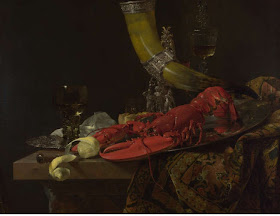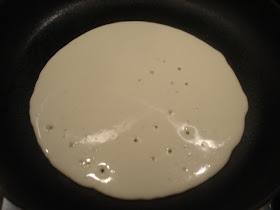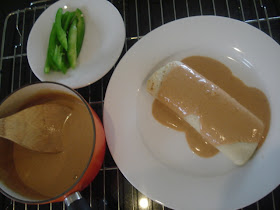The Four Elements Room 11
In room 11 of the National Gallery you can find the masterpieces of Joachim Beuckelaer (1533–574) another Flemish painting where many of his painting include pictures of food and markets. The National Gallery since 2004 managed to have in the same room the series of The Four elements where the fish stall means water, the butchers fire, the earth is represented by the vegetables and a poultry stall in the market means air.
Still Life with Drinking-Horn Room 22
Williem Kalf painted a collection of exotic and opulent object with a great brilliance and depth of colour. A lobster , a drinking horn, a half peeled lemon look so real that you feel that you can start to cook with them at any moment.
The Effects of Intemperance Room 22
Jan Steen started to paint landscapes but soon started to paint controversial scenes of the middle class influenced by the merrymaking that he saw at that time. I like this picture because it shows a believed strict society under the alcohol effect like the snoozing woman or the old man in the back misbehaving with a young lady. The weakness of the elderly encourages the misbehaving of the children. A scene that many modern families are still contemplating. In room 27 is another Jan Steen picture where an oyster is used like a symbol of lust
A Poulterer's Shop Room 27
Gerrit Dou painting is around 1670, he specialised in genre scenes of his time like this poultry shop painted in very deep details like we feel we are inside the shop. The scene makes you think of those moments when you are in the fresh market and the owner is telling you how is the best way to cook the hare or where the precious hare came from.
A Lady in a Garden with Children Room 33
Nicolas Lancret painted the main figures to one side of the picture to show us an almost pastoral scheme of the French aristocrat class before The Revolution. Pay attention to the little girl sipping chocolate and abandoned her doll in favour to join to an afternoon tea, something that any child will do even today, just change the doll for a console game and the setting for an Ikea kitchen.
La Fontaine Room 33
Still Life with Lemons and Oranges Room 39
Still Life with Apples and a Pomegranate Room 41
Gustave Courbet (1819-77) was a French painter who led the Realist movement in 19th-century French painting that also had very clever quotes. Most of the Still Life paintings were painted when he was in prison, his sisters brought him fruit and flowers as subjects for his canvases. Many of these represent fruit in landscape settings.
Bowl of Fruit and Tankard before a Window Room 45
This picture is believed to be an act of homage to a painting which Paul Gauguin (1848-1903) had acquired earlier, Cézanne's 'Still Life with Compotier, Glass and Apples' (Museum of Modern Art, New York). Gaugin instead paints the bowl of fruit in full details using the colours for pure decorative and emotional purposes with non-naturalistic approach of painting with very simplified brush touches. At the time he painted the picture he was living in Haiti, but is believed that the background town is based on a picture of Pont-Aven
The Arnolfini Portrait Room 56












.JPG)






